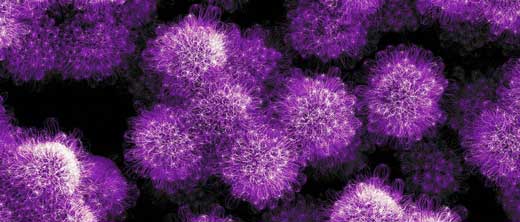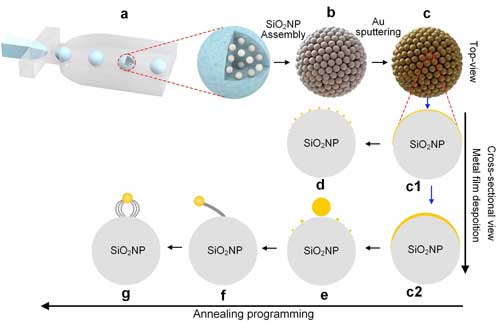| Mar 10, 2020 | |
Bouquets of nanoflowers with a golden touch(Nanowerk News) Using nano size spheres as a starting point, researcher Juan Wang of the University of Twente (MESA+ Institute) creates fascinating structures that can have a wide range of shapes and functionalities. They can even get a beautiful flower-like appearance, with nanowires connected by gold nanospheres. |
|
| The new nanostructures can be designed for detecting chemical or biological substances at their surface. They have unique optical properties and can also be used for mimicking a biological surface at which water strongly sticks or, instead, easily rolls of. | |
 |
|
| Flower-like spheres with nanowires connected by gold at the top. (Image: University of Twente) | |
| Building with nanospheres makes it possible to, step by step, add functionality. The simplest starting point is a sphere made of silica glass, while the end result can be a of a sphere coated with tiny gold spheres or a with nanowires sticking out: then they look like the sphere-shaped Allium flower. | |
| By combining spheres and creating a ‘wrinkly’ surface, a bio-inspired surface is possible that has the sticky characteristics of a rose petal, or the water repellent behavior of a Lotus leaf instead. | |
Color code |
|
| Wang describes other powerful combinations. As the spheres can act as photonic crystals, reflecting a specific color of light, they can together form a color ‘watermark’ that can’t be copied. In materials analysis, the technique of surface plasmon resonance (SPR) is often used in combination with gold surfaces: that’s why gold-covered spheres are very interesting. | |
| SPR works by shining light on the surface for activitating electrons: locally the reflected light then gives information about the substance on top of the gold. Combining SPR with the photonic crystal behavior, may even lead to materials analysis using a simple color scan, where the color shift can be used as an indication of the binded substances, for example for diagnostics. | |
 |
|
| From a basic sphere to a sphere with nanowires and gold: a bottom-up approach to nanofabrication. (Image: University of Twente) | |
| The flower-like spheres, of which the silica nanowires are connected by gold on top, have special wetting properties. They could be used for separating oil and water, or in microreactors. | |
Nanofabrication |
|
| Wang’s approach of nanomanufacturing is typically ‘bottom-up’: she starts with a basic component and adds functionality by adding new particles with different length scales. In most nanomanufacturing techniques, the structures are formed by removing material by etching, adding a new layer, again etching patterns in the new layer, and so on. The new, bio-inspired approach adds a powerful platform to fields like microfluidics, photonics and materials engineering. | |
| Juan Wang (1991, Baoji, China) did her research in the BIOS Lab-on-a-Chip Group, part of UT’s MESA+ Institute, and at the South China Academy of Advanced Optoelectronics (South China Normal University, Guangzhou). She defended her PhD thesis on March 6. The title is ‘3D Hierarchical Particle Assemblies with Nanostructure-Enabled Functionalities’. |
| Source: University of Geneva | |
|
Subscribe to a free copy of one of our daily Nanowerk Newsletter Email Digests with a compilation of all of the day's news. |
